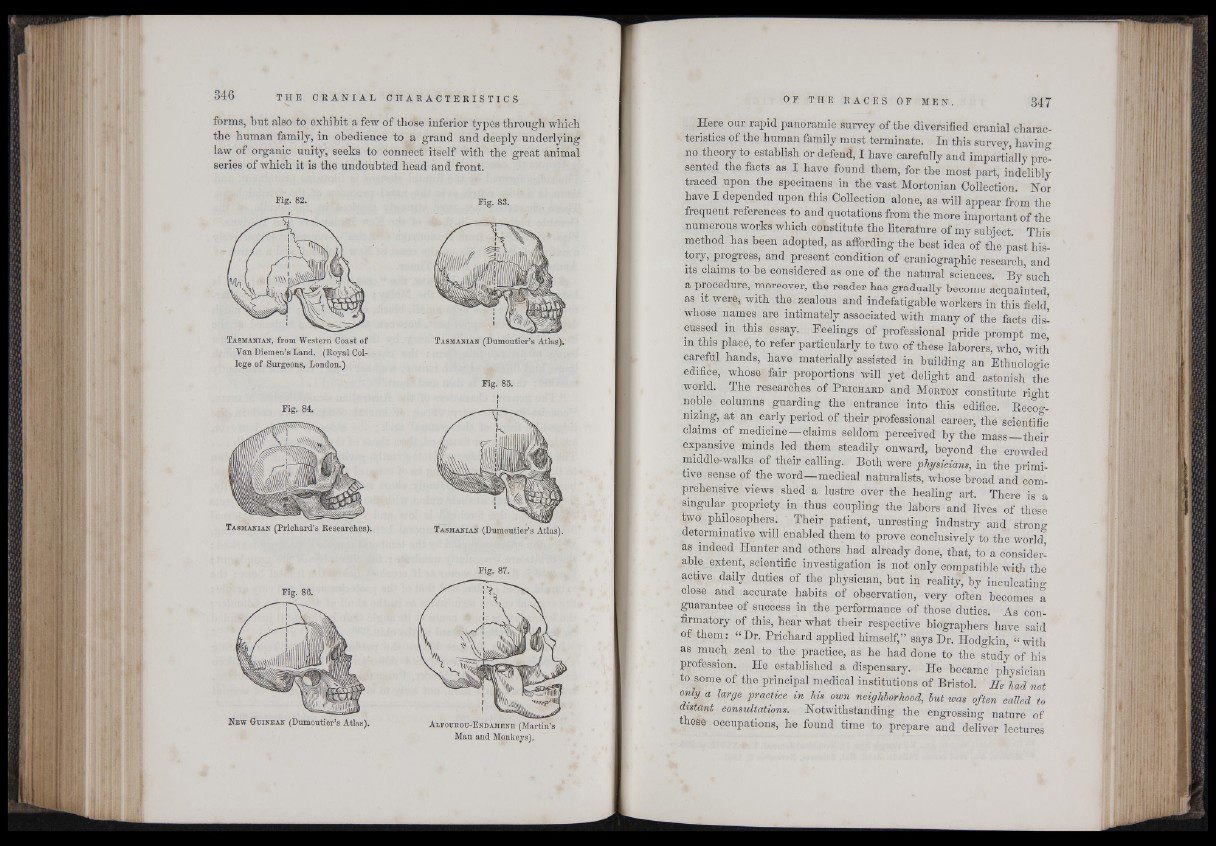
forms, but also to exbibit a few of those inferior types through which
the human family, in obedience to a grand and deeply underlying
law of organic unity, seeks to connect itself with the great animal
series of which it is the undoubted head and front.
Fig. 82.
T a s m a n i a » (Prichard’s Researches).
Fig. 83.
T a s m a n i a n , from Western Coast of
Van Diemen’s Land. (Royal College
of Surgeons, London.)
Fig. 84.
T a s m a n i a n (Dumoutier’s Atlas).
Fig. 85.
i
T a s m a n i a n (Dumoutier’s Atlas).
Fig. 88.
Fig. 87.
N e w G u i n e a n (Dumoutier’s Atlas). A l f o u b o u - E n h a m e n f , (Martin’s
Man and Monkeys).
Here our rapid panoramic survey of the diversified cranial characteristics
of the human family must terminate. In this survey, having
no theory to establish or defend, I have carefully and impartially presented
the facts as I have found them, for the most part, indelibly
traced upon the specimens in the vast Mortonian Collection Nor
have I depended upon this Collection alone, as will appear from the
frequent references to and quotations from the more important of the
numerous works which constitute the literature of my subject. This
method has been adopted, as affording the best idea of the past his-
f°ry> progress, and present condition of craniographic research, and
its claims to be considered as one of the natural sciences. By’such
a procedure, moreover, the reader has gradually become acquainted
as it were, with the zealous and indefatigable workers in this field’
whose names are intimately associated with many of the facts discussed
in this essay. Feelings of professional pride prompt me
in this placé, to refer particularly to two of these laborers, who, with
careful hands, have materially assisted in building an Ethnologic
edifice, whose fair proportions will yet delight and astonish the
world. The researches of P richard and M orton constitute right
noble columns guarding the entrance into this edifice. Recognizing,
at an early period of their professional career, the scientific
claims of medicine—claims seldom perceived by the mass—their
expansive minds led them steadily onward, beyond the crowded
middle-walks -of their calling. Both were physiciàns, in the primitive
sense of the word—medical naturalists, whose broad and comprehensive
views shed a lustre over the healing art. There is a
singular propriety in thus coupling the labors and lives of these
two philosophers. Their patient, unresting industiy and strong
determinative will enabled them to prove conclusively to the worlcf
as indeed Hunter and others had already done, that, to a considerable
extent, scientific investigation is not only compatible with the
active daily duties of the physician, but in reality, by inculcating
close and accurate habits of observation, very often becomes a
guarantee of success in the performance of those duties. As confirmatory
of this, hear what their respective biographers have said
of them: “ Dr. Prichard applied himself,” says Dr. Hodgkin, “ with
as much zeal to the practice, as he had done to the study of his
profession. He established a dispensary. He became physician
to some of the principal medical institutions of Bristol. He had not
only a large practice in his own neighborhood, hut was often called to
distant consultations. Notwithstanding the engrossing nature of
these occupations, he found time to prepare and deliver lectures